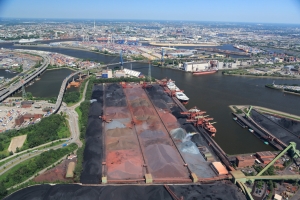


(Posted on 24/05/18)
This year’s first-quarter throughput total was notable for a rise in conventional general cargoes, a lower figure of bulk cargoes, a stable trend in container handling and distinct growth on container transport services by rail.
In the first quarter of 2018, the Port of Hamburg achieved total throughput of 32.7m tonnes (down 7.5 per cent). In Hamburg this heading covers general cargo throughput of 22.7m tonnes (down 1.8 per cent) and bulk cargo throughput of 10m tonnes (down 18.2 per cent). In the bulk cargo throughput segment, it was impossible to match the fresh record throughput total of 12.2m tonnes achieved in the first quarter of 2017, with markets causing downturns in all three sub-segments: suction, grab and liquid cargoes. On the import side, general cargo handling at 11.5m tonnes was ahead by 3.1 per cent. At 11.2m tonnes (down 6.3 per cent), exports were somewhat weaker. The trend on conventional general cargo throughput proved highly satisfactory. Totalling 370,000 tonnes, first-quarter throughput here rose by 14.3 per cent, maintaining the upward trend started in the fourth quarter of 2017. Container handling in the first quarter of 2018 remained stable at 2.2m TEU (down 1.9 per cent), only just below the comparable figure for the previous year. At 612,000 TEU, container transport by rail achieved a notable advance of 4.1 per cent. Hamburg extended its leading position as Europe’s largest rail port.
“A glance at handling trends for first-quarter handling of loaded and empty containers indicates that on the one hand, the Port of Hamburg still continues to gain cargoes, but on the other has to accept a sharp drop in the volume of empty containers. Against the background of the not yet implemented adjustment of the fairway of the Lower and Outer Elbe, shipowners are primarily using their slot capacities on ULCVs calling at Hamburg for loaded boxes. With general cargo volume almost equally balanced between import and export tonnage, Hamburg is extremely attractive for shipowners aiming for optimal utilization of their vessels. Whether for import or export, a mass of cargo beckons in Germany’s largest port. By contrast with loaded boxes, empty ones are less port-related and routing these is therefore a more volatile process,” explained Axel Mattern, Joint CEO of Port of Hamburg Marketing.
Euroports has announced the renewal of the concession for Terminal Rinfuse Venezia (TRV) at Porto Marghera... Read more
Contributing to the commitment of achieving net zero emissions by 2050, the Panama Canal authority has... Read more
The Saguenay Port Authority in Quebec has ordered a Konecranes Gottwald ESP.6B Mobile Harbor Crane for... Read more
North Sea Port Supervisory Body has appointed Cas König as the port authority's new CEO. Kö... Read more
After 19 years at the helm of the Port of Trois-Rivières and a career rich in major projects,... Read more
Abu Dhabi based AD Ports Group, an enabler of integrated trade, transport and logistics solutions, has... Read more
The Port of Rotterdam and Port of Antwerp-Bruges have welcomed the Clean Industrial Deal, through which... Read more
The Canadian Port of Trois-Rivières is delighted to have received major funding of $87.1 million... Read more
Belgian logistics giant Katoen Natie has ordered four all-electric Konecranes Gottwald Mobile Harbor... Read more
AD Ports Group, Abu Dhabi based enabler of integrated trade, transport and logistics solutions, has... Read more